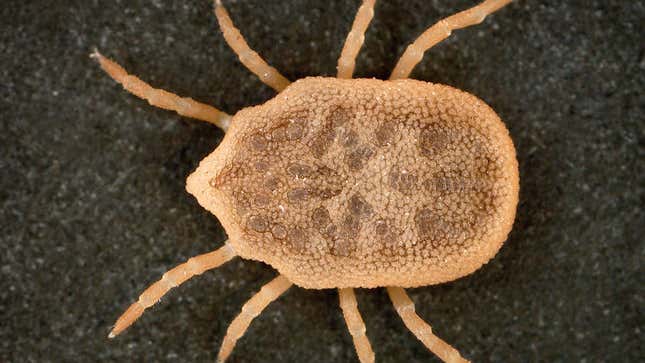
Right now, as summer broils the northern hemisphere, countless animals are trying to dump heat. Dogs are panting. Burrowing animals are scurrying underground. Humans are sweating buckets (and we’re extremely good at sweating). But when ticks need to cool off, they really commit. In a blow to the sterling reputation of the tick, new research suggests that the parasites keep cool by pissing on themselves.
However, these piddling parasites aren’t fighting against the seasonal solar kiln outside. It’s their living food that’s the problem. Many ticks feed entirely on the blood of warm-blooded animals, which is—shockingly—quite warm. Gorging on the red stuff causes a dramatic spike in body temperature for a tick, like if you or I chugged two dozen gallons of steaming tomato bisque in a single sitting.
Claudio Lazzari, a behavioral physiologist at the University of Tours in France, and his colleagues were studying how ticks and other blood-feeding arthropods, like mosquitos and kissing bugs, dealt with a boiler in their bellies. The work of Lazzari’s team and other laboratories had previously shown that some species boost production of heat shock proteins, which help cells recover from the nasty effects of heat stress.
To better understand how these blood-feeders regulate their body temperature when drinking, Lazzari and his team looked to a type of South American tick, Ornithodoros rostratus, that feeds on a wide range of mammals, including humans. The researchers used a thermographic camera, which creates an image using infrared light, to track the body heat of the ticks as they fed on mice in the laboratory.
As the hungry arachnids turned into turgid blood bags, their temperature predictably rose, but then something strange happened. Large amounts of fluid would collect underneath the ticks, seeping out of special glands near the base of the legs. It was pee.
“We had never before observed ticks producing such an amount of urine,” said Lazzari.
Soon after this mealtime micturition, the ticks’ temperature started to drop, falling by as much as 3 degrees Celsius, the team reports in a not-yet peer-reviewed paper uploaded to the preprint server BioRxiv.

It appears as though the ticks’ weird body surface might play a role in this cooling system. Unlike most ticks, Ornithodoros ticks don’t have a hard, plate-like scutum that gives the most familiar ticks their flat, guitar pick-like shape. Instead, these “soft ticks” have a rough, raisin-like body surface full of convolutions. When the team put tiny drops of fluorescent fluid on the ticks to trace the fluid’s spread over their surface, they found that fluid rapidly flows into all the ticks’ back folds, thanks to capillary action.
The researchers think that when pee is spread over such a large surface area, it results in evaporative cooling—the same mechanism behind sweat’s cooling properties as it evaporates off your hot skin.
“When you blood-feed, it’s one of the most rapid temperature transitions for an organism that occurs. You go from 20 degrees Celsius to 34 degrees Celsius in like 10 seconds,” said Joshua Benoit, an insect physiologist at the University of Cincinnati who was not involved with the study. “It’s pretty abrupt, I mean, [humans] would pass out if we heated up that quickly.”
“You don’t want to be in the middle of a blood meal and pass out,” said Benoit.
Benoit says Ornithodoros’ apparent need to promptly cool off makes sense, given how soft ticks tend to feed by running up to a host, guzzling, and swelling to 12 times their body weight with blood over a few minutes, rather than the hours to days that hard ticks spend feeding on a host.
Guilherme Gomes, an animal physiologist at the University of São Paulo in Brazil also not involved with this study, said the findings are interesting but is curious to know how humidity conditions impact the ticks and their pee-based AC, because at very high humidity, some organisms actually absorb water from the air and excrete it in excess.
The new study reveals the first “thermoregulatory” ability associated with blood-feeding in arachnids, but insects have their own strategies. Some mosquitos release an unholy cocktail of urine, undigested blood, and other bodily fluids to cool down their abdomen when drinking. Kissing bugs have a heat exchanger system in their heads. Even non-blood feeders—like honeybees and moths—will barf up nectar on their faces to beat the heat.

Soft ticks aren’t the first animals known to cool off by peeing all over themselves. Turkey vultures and storks will let loose all over their legs as a way to cool off. Benoit said urine is a fine substitute for sweat.
“If you’re just trying to eliminate this excess fluid,” he said, “and you need it to evaporatively cool, it will work.”
It’s unclear if self-dowsing incurs any real cost to the ticks.
“The metabolic cost would probably be important,” said Lazzari, “but it has not been yet measured.”
Going forward, Lazzari wants to look into more of these strategies for dealing with a warm blood belly, evaluating what kinds of physiological tradeoffs these little vampires are making as they eat.